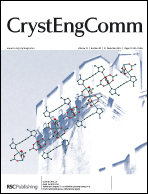Construction of N,N′-di(3-pyridyl)adipoamide-based Zn(ii) and Cd(ii) coordination networks by tuning the isomeric effect of polycarboxylate ligands†
Abstract
Eight new Zn(II) and Cd(II) coordination networks containing N,N′-di(3-pyridyl)adipoamide (L) and polycarboxylate ligands, {[Zn2(2,5-PDC)2(L)(H2O)2]·2H2O}∞ (H2PDC = 2,5-pyridinedicarboxylic acid), 1, [Zn2(2,6-PDC)2(L)]∞, 2, {[Zn2(3,4-PDC)2(L)(H2O)6]·4H2O}∞, 3, {[Cd(2,6-PDC)(L)(H2O)]·4H2O}∞, 4, [Zn(1,3,5-HBTC)()]∞ (H3BTC = benzenetricarboxylic acid), 5, {[Cd(1,2,3-HBTC)(L)(H2O)]·H2O}∞, 6, {[Cd2(1,3,5-HBTC)2(L)(H2O)2]·2H2O}∞, 7, and {[Zn3(1,2,4-BTC)2(L)(H2O)4]·4H2O}∞, 8, have been synthesized by hydrothermal reactions and characterized by single crystal X-ray crystallography. Structural analysis reveals that 1 and 2 form pleated hcb layers with 1D helical chains, in which the layers of 1 interdigitate with each other and those of 2 are linked by the π–π stacking interactions. Complexes 3 and 4 exhibit 1D ladders with single and double rungs, respectively, whereas 5 shows a 2D pleated net with the sql topology, 6 displays a 3D dia coordination network and 7 forms a 2D structure with the (63)(66)-3,4L88 topology. The BTC3− ligands in 8 adopt the μ4-bonding modes, resulting in a 3D coordination network with the rare (65·8)-hxg-d-4-P2/c topology. The various bonding modes, the ligand-isomerism of the polycarboxylate ligands and the identity of the metal center play important roles in determining the structural diversity. Their thermal and luminescent properties are also discussed.


 Please wait while we load your content...
Please wait while we load your content...